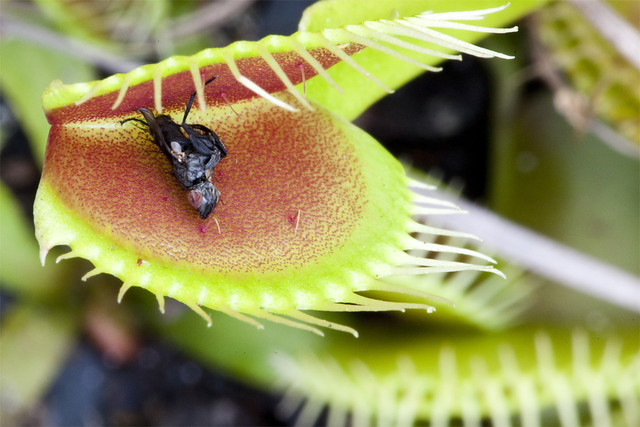1. Plants had evolved from charophytes.
2.The biggest challenge that is faced by plants as they colonized to algae and fungi.
Wednesday 12 June 2013
Modern Synthesis
That the venus flytrap is an extremely rare plant but really difficult to grow and it only can grow in North Carolina. When an insect for example the fly, if it land in the venus flytrap's mouth and suddenly touches the trigger in the plant then the venus flytrap will rapidly close and digest the insect. Not all plants can do that only carnivorous plant are able to eat an insect and digest it.
Monday 10 June 2013
Special Adaptations
The special adaptions of a venus flytrap is that the nectar that is the chemical mix, which attracts any type of insects. If the insects had touched the hair or trigger, rapidly the venus flytrap will close it mouth and squeeze the insect like it is choking the insect until it is unable to breathe that way it is able to digest the insect easier. it is sort of like an anaconda but like a plant and the way it start to chokes the insect in a different way.
Evolution by natural selection
Charles Darwin would say about the most common known carnivorous plant called the venus flytrap that this type of unique species are rare that it is the only plant that is name is well common known for people to know. The venus flytrap has special moves how the way the plant traps the insect with a rapidly force to close the mouth, when the insect had touched one of the trigger that is inside that plant. The venus flytrap opens its mouth only 90 degrees for catching bigger insects such as the grasshopper and wasps.
Sunday 9 June 2013
Lamarckian evolution
In the lacmarckian evolution, Jean Baptiste de Lamarck would describe the venus flytrap that how will the venus flytrap will able to close its mouth with a huge insect that is inside of the venus flytrap mouth. Also how does it digest the insect because it is not an animal, it is only a plant. How can a plant can only survive in North Carolina but not the rest of the states in U.S.A and also in the countries. Also how can a venus flytrap can eat an insect if it doesn't have any animal organs to digest the insect.
Coevolution of a venus flytrap
The coevolution of a venus flytrap is that it captures insects by having chemical mix nectar that able to attracts the insects and once the insect hit the trigger, that is inside of the plant, the venus flytrap will capture the insect then it will eat it. The Dionaea muscipula is related to the Aldrovanda vesiculosa which is known as the waterwheel plant. The reason why those two plants are related is because both of the plants are carnivorous plants. Also the venus flytrap and the waterwheel plant are being threatened and endangered species.
Human Influence
Venus flytraps are endangered species and can be also threatened by humans because the venus flytrap can only grow in North Carolina. The reason why the venus flytrap can only grow in North Carolina is because it grows in the tropical counties. But people decide to grow near clod areas and also it is very hard to know when and how much of water to grow a venus flytrap. Venus fly trap are considered to be threatened because these kind of plants are suppose to be growing in the southeast of North America or the U.S.A and in North Carolina. The venus flytrap has a chemical mix which bugs such as flies that eat it. The venus flytrap can only make these type of chemicals in North Carolina. But many people don't know about that they just take it and rather plant it in a different place besides North Carolina.
Thursday 6 June 2013
General Adaptations
The venus flytrap are grown in the the tropical lands in North America such as North Carolina and in the southern eastern of U.S.A. The venus flytrap does need 1/4 inch of distilled, reverse-osmosis water and rain water. So you will need to water it once a week and need to use less water.
Monday 3 June 2013
Biogeography, Ecology & Habitat
The habitat where a venus flytrap can be found is in the coastal lines of south and north Carolina and the southern part of U.S.A and California or Florida. The venus flytrap could be found in North America and it attracts flies because it has nectar on its mouth which flies eat.
Taxonomy
The types of taxonomy are called domain, kingdom, phylum, class, order, family, genus and species. The domain of a venus flytrap is called an Eukarya which means that the venus flytrap is a multicellular organism that contains the membrane-bound organelles. The kingdom of the venus flytrap is called a Plantae. The venus flytrap is the photosynthesis and reproducing with an alternation between gameotophyte and sporophyte. The phylum of a venus flytrap is called an Anthophyta. The venus flytrap are produced by these organisms and double fertilization is a type of reproduction flower. The class of a venus flytrap is called a Magnoliopsida which the seeds of a venus flytrap are dicots. The order of a venus flytrap is called a Caryophyllales when the venus flytrap can have free-central and basal placentation. The family of a venus flytrap is called Droseraceae which means the venus flytrap are carnivorous plants that use their mouth to catch their prey. The genus of a venus flytrap is called a Dionaea which means that the venus flytrap can have spines that assist to to catch their prey such as flies. The species of a venus flytrap is called a Dionaea muscipula which means that it is a monotypical species.
Subscribe to:
Posts (Atom)








